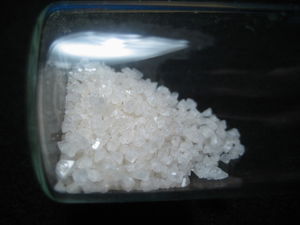Barium nitrate
 Barium nitrate crystals
| |
| Names | |
|---|---|
| IUPAC name
Barium nitrate
| |
| Systematic IUPAC name
Barium nitrate | |
| Other names
Barium dinitrate
| |
| Identifiers | |
| Jmol-3D images | Image |
| |
| Properties | |
| Ba(NO3)2 | |
| Molar mass | 261.337 g/mol |
| Appearance | White hygroscopic solid |
| Odor | Odorless |
| Density | 3.24 g/cm3 |
| Melting point | 592 °C (1,098 °F; 865 K) (decomposes) |
| Boiling point | Decomposes |
| 4.95 g/100 mL (0 °C) 10.5 g/100 mL (25 °C) 34.4 g/100 mL (100 °C) | |
| Solubility | Insoluble in alcohols, halocarbons, hydrocarbons |
| Vapor pressure | ~0 mmHg |
| Hazards | |
| Safety data sheet | Sigma-Aldrich |
| Flash point | Non-flamable |
| Lethal dose or concentration (LD, LC): | |
| LD50 (Median dose)
|
187 mg/kg (rat, oral) |
| Related compounds | |
| Related compounds
|
Barium nitrite |
| Except where otherwise noted, data are given for materials in their standard state (at 25 °C [77 °F], 100 kPa). | |
| Infobox references | |
Barium nitrate is a chemical compound with the formula Ba(NO3)2, mainly used as an oxidizer.
Contents
[hide]Properties
Chemical
When heated at temperatures over 592 °C, barium nitrate decomposes to give off nitrogen dioxide fumes and oxygen:
- Ba(NO3)2 → BaO + 2 NO2 + ½ O2
If barium nitrate is heated in an atmosphere of nitric oxide, barium nitrite (Ba(NO2)2) results:
- Ba(NO3)2 + 2 NO → Ba(NO2)2 + 2 NO2
If dry finely powdered barium nitrate is added to concentrated sulfuric acid, barium sulfate will precipitate, and nearly anhydrous nitric acid will be produced.
Physical
Barium nitrate is an odorless white hygroscopic solid, slightly soluble in water and insoluble in alcohols.
Availability
Barium nitrate can be found in many common sparklers. The sparkler paste consists of barium nitrate, aluminium + magnesium powders (sometimes iron), pressed together with a glue. The barium nitrate can be extracted by dissolving the sparkler paste with an organic solvent, followed by rinsing the resulting glue-free powder with COLD water. Do not use warm or hot water, as it will react with the magnesium and aluminium powder to form a gel which is a pain to remove. The barium nitrate solution is filtered and recrystallized.
Barium nitrate also occurs naturally as the rare mineral nitrobarite.
Preparation
Barium nitrate can be prepared by reacting barium oxide, hydroxide or carbonate with nitric acid and recrystallizing it from the resulting solution.
It can also be prepared by reacting barium chloride with sodium nitrate or silver nitrate, followed by filtering and recrystallizing the barium nitrate from the filtered solution.
Make sure that your nitrate source is very pure, as any sulfate present will cause the barium to precipitate out of the solution.
Projects
- Make flash powders
- Thermite booster
- Make Thermate-TH3
- Make Baratol
Handling
Safety
Barium nitrate is a strong oxidizer and will ignite many combustible materials if heated with an open flame.
Barium nitrate is somewhat soluble in water, which makes it toxic. Solutions of soluble sulfate salts, such as Epsom salts (magnesium sulfate) or sodium sulfate may be given as first aid for barium poisoning, as they precipitate the soluble barium to the insoluble (and non-toxic) barium sulfate.
Storage
Barium nitrate should be stored in closed bottles, away from moisture and flammable materials as well as acidic vapors. A glass or plastic bottle with cap is good enough.
Disposal
Barium nitrate should be converted to the less toxic barium sulfate and dumped in trash or recycled if possible.
Gallery
References
Relevant Sciencemadness threads
- Chemical pages without CAS Registry Number
- Articles without EBI source
- Chemical pages without ChemSpiderID
- Chemical pages without DrugBank identifier
- Articles without KEGG source
- Articles without InChI source
- Articles without UNII source
- Articles containing unverified chemical infoboxes
- Chemical compounds
- Inorganic compounds
- Barium compounds
- Nitrates
- Oxidizing agents
- Easily prepared chemicals
- Readily available chemicals
- Heavy metal toxicants
- Essential reagents
